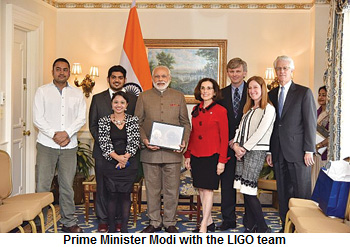INDIAN ARMED FORCES CHIEFS ON
OUR RELENTLESS AND FOCUSED PUBLISHING EFFORTS

SP Guide Publications puts forth a well compiled articulation of issues, pursuits and accomplishments of the Indian Army, over the years

I am confident that SP Guide Publications would continue to inform, inspire and influence.

My compliments to SP Guide Publications for informative and credible reportage on contemporary aerospace issues over the past six decades.
- Prime Minister witnesses 'Bharat Shakti' – a Tri-Services Firing and Manoeuvre Exercise in Pokhran, Rajasthan
- Interim Defence Budget 2024-25 — An Analysis
- Union Defence budget 2024
- Prime Minister Modi Commemorates Indian Navy Day in a Grand Ceremony
- Prime Minister Modi Flies in the LCA Tejas
- New Chapter in India-Italy Defence Ties
- Airpower beyond Boundaries
The LIGO project

Amidst the commotion of the Nuclear Security Summit 2016 held in Washington DC, signing of the Indo-US MoU on the setting up of Laser Interferometer Gravitational-Wave Observatory (LIGO) in India largely went unnoticed. The LIGO project recently proved the existence of gravitational waves envisaged by Albert Einstein a century ago. Interestingly, Einstein had gone on record to say, “We owe a lot to the Indians, who taught us how to count, without which no worthwhile scientific discovery could have been made.”
Now it is India’s turn to join research on gravitational waves that were first visualised by Einstein. This will be the third LIGO observatory, and the first one outside the US. The LIGO, funded by America’s National Science Foundation (NSF), is the largest and most ambitious project ever funded by the NSF, collaborating more than 900 scientists worldwide as well as 44,000 activeEinstein@Home users. The LIGO project is run with the collaboration of 90 universities and research institutions. 30 people of Indian origin are part of the LIGO project. The two existing LIGO observatories are located at Hanford, Washington, and Livingston, Louisiana, and are operated by Caltech and MIT. While India will now join the league of countries supporting research on gravitational waves with setting up of this LIGO observatory, US, UK, Italy, Germany and Japan have ongoing research in the area.
The proposed observatory in India was discussed between India and US in June 2012. The basis of the LIGO-India project entailed transfer of one of LIGO’s detectors from US to India, which would have affected work and scheduling on the Advanced LIGO upgrades already underway. In August 2012, US approved the LIGO Laboratory’s request to modify the scope of Advanced LIGO by not installing the Hanford “H2” interferometer, and to prepare it instead for storage in anticipation of sending it to LIGO-India. The first direct detection of gravitational waves was announced by the scientists on February 11, 2016, opening a new window onto the cosmos. Immediately after this landmark discovery, Prime Minister Narendra Modi announced on February 17, 2016, that the Cabinet had granted ‘in-principle’ approval to the Rs. 1,200-crore LIGO-India mega science proposal.
Construction and completion of the third LIGO interferometer is to be taken up shortly, and the observatory is expected to be functional by 2023, which will significantly improve the ability of scientists to pinpoint the sources of gravitational waves and analyse the signals. Gravitational waves are ripples in the fabric of space and time produced by dramatic events in the universe, such as merging black holes, and predicted as a consequence of Albert Einstein’s 1915 general theory of relativity carry information about their origins and about the nature of gravity that cannot otherwise be obtained.
LIGO Director Dr France A. Cordov has said that with the additional gravitational wave detector, located in India, LIGO and its hundreds of associated scientists worldwide are positioned to take this nascent field of gravitational wave science to the next level, adding, that the third detector would be able to ‘triangulate’ the source of gravitational waves and thus make other, more detailed observations.
The Indian Cabinet while approving LIGO-India had said that the project “will also bring considerable opportunities in cuttingedge technology for the Indian industry” which will be responsible for the construction of the new observatory’s four-kilometre-long beam tubes, and the project will motivate Indian students and young scientists to explore newer frontiers of knowledge; giving further impetus to scientific research in the country. The beams monitor the distance between mirrors precisely positioned at the ends of the arms. According to Einstein’s theory, the distance between the mirrors will change by an infinitesimal amount when a gravitational wave passes by the detector. A change in the lengths of the arms smaller than one-ten-thousandth the diameter of a proton (10-19 metre) can be detected. The degree of precision achieved by Advanced LIGO is analogous to being able to measure the distance between our solar system and the sun’s nearest neighbour Alpha Centauri (about 4.4 light years away) accurately to within a few microns, a tiny fraction of the diameter of a human hair.
Prime Minister Modi had met LIGO scientists in Washington DC two days after he met scientists from the Institute of Plasma Research in New Delhi, who are also working on the LIGO project. Joining the LIGO project undoubtedly is an excellent scientific initiative since it will benefit multiple applications with far-reaching consequences.





